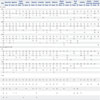1. Cohen LL, La Greca AM, Blount RL, Kazak AE, Holmbeck GN, Lemanek KL. Introduction to special issue: evidence-based assessment in pediatric psychology. J Pediatr Psychol. 2008; 33:911–915.

2. Gladman M, Lancaster S. A review of the behaviour assessment system for children. Sch Psychol Int. 2003; 24:276–291.

3. Reynolds CR, Kamphaus RW. BASC-2: Behavior Assessment System for Children: Manual. 2nd ed. Circle Pine, MN: American Guidance Service;2004.
4. Jarratt KP, Riccio CA, Siekierski BM. Assessment of attention deficit hyperactivity disorder (ADHD) using the BASC and BRIEF. Appl Neuropsychol. 2005; 12:83–93.

5. Ostrander R, Weinfurt KP, Yarnold PR, August GJ. Diagnosing attention deficit disorders with the behavioral assessment system for children and the child behavior checklist: test and construct validity analyses using optimal discriminant classification trees. J Consult Clin Psychol. 1998; 66:660–672.

6. Bevaart F, Mieloo CL, Jansen W, Raat H, Donker MC, Verhulst FC, et al. Ethnic differences in problem perception and perceived need for care for young children with problem behaviour. J Child Psychol Psychiatry. 2012; 53:1063–1071.

7. Crijnen AA, Achenbach TM, Verhulst FC. Problems reported by parents of children in multiple cultures: the Child Behavior Checklist syndrome constructs. Am J Psychiatry. 1999; 156:569–574.
8. Rescorla LA, Achenbach TM, Ivanova MY, Harder VS, Otten L, Bilenberg N, et al. International comparisons of behavioral and emotional problems in preschool children: parents' reports from 24 societies. J Clin Child Adolesc Psychol. 2011; 40:456–467.

9. Brewis AA, Piñeda D. Population variation in children's behavioral symptomatology. Am J Phys Anthropol. 2001; 114:54–60.

10. Jung WS, Stinnett TA. Comparing judgments of social, behavioural, emotional and school adjustment functioning for Korean, Korean American and Caucasian American children. Sch Psychol Int. 2005; 26:317–329.

11. Kim YS, Leventhal BL, Koh YJ, Fombonne E, Laska E, Lim EC, et al. Prevalence of autism spectrum disorders in a total population sample. Am J Psychiatry. 2011; 168:904–912.

12. Oh KJ, Lee HR. Development of Korean version of child behavior checklist (K-CBCL). Seoul: Korean Research Foundation Report;1990.
13. Kwak KJ, Park HW, Kim CT. Korean-Wechsler Intelligence Scale for Children-Third Edition. Seoul: Special Education Publishing Co.;2001.
14. Shin MS, Cho SC. Korean Leiter international Performance Scale-Revised. Seoul: Hakjisa;2010.
15. George D, Mallery P. SPSS for Windows step by step: a simple guide and reference, 11.0 update. 4th ed. Boston: Allyn and Bacon;2003.
16. Rouquette A, Falissard B. Sample size requirements for the internal validation of psychiatric scales. Int J Methods Psychiatr Res. 2011; 20:235–249.

17. Kim YS, So YK, Noh JS, Choi NK, Kim SJ, Koh YJ. Normative data on the Korean ADHD rating scales (K-ARS) for parents and teacher. J Korean Neuropsychiatr Assoc. 2003; 42:352–359.
18. Jang SJ, Suh DS, Byun HJ. Normative study of the K-ARS (Korean ADHD Rating Scale) for parents. J Korean Acad Child Adolesc Psychiatry. 2007; 18:38–48.
19. DuPaul GJ, Anastopoulos AD, Power TJ, Reid R, Ikeda MJ, McGoey KE. Parent ratings of Attention-Deficit/Hyperactivity Disorder symptoms: factor structure and normative data. J Psychopathol Behav Assess. 1998; 20:83–102.
20. Cho SC, Shin YO. Prevalence of disruptive behavior disorders. J Korean Acad Child Adolesc Psychiatry. 1994; 5:141–149.
21. Yang SJ, Cheong S, Hong SD. Prevalence and correlates of attention deficit hyperactivity disorder: school-based mental health services in Seoul. J Korean Neuropsychiatr Assoc. 2006; 45:69–76.
22. Chung KM, Ebesutani C, Bang HM, Kim J, Chorpita BF, Weisz JR, et al. Parenting stress and child behavior problems among clinic-referred youth: cross-cultural differences across the US and Korea. Child Psychiatry Hum Dev. 2013; 44:460–468.

23. Oh KJ, Shin YJ, Moon KJ, Hudson JL, Rapee RM. Child-rearing practices and psychological disorders in children: cross-cultural comparison of Korea and Australia. Yonsei Med J. 2002; 43:411–419.

24. Rajendran K, O'Neill S, Halperin JM. Inattention symptoms predict level of depression in early childhood. Postgrad Med. 2013; 125:154–161.

25. Volker MA, Lopata C, Smerbeck AM, Knoll VA, Thomeer ML, Toomey JA, et al. BASC-2 PRS profiles for students with high-functioning autism spectrum disorders. J Autism Dev Disord. 2010; 40:188–199.

27. Merikangas KR, He JP, Burstein M, Swendsen J, Avenevoli S, Case B, et al. Service utilization for lifetime mental disorders in U.S. adolescents: results of the National Comorbidity Survey-Adolescent Supplement (NCS-A). J Am Acad Child Adolesc Psychiatry. 2011; 50:32–45.

28. Bölte S, Poustka F. The relation between general cognitive level and adaptive behavior domains in individuals with autism with and without co-morbid mental retardation. Child Psychiatry Hum Dev. 2002; 33:165–172.
29. Kenworthy L, Case L, Harms MB, Martin A, Wallace GL. Adaptive behavior ratings correlate with symptomatology and IQ among individuals with high-functioning autism spectrum disorders. J Autism Dev Disord. 2010; 40:416–423.

30. Billstedt E, Gillberg IC, Gillberg C. Autism after adolescence: population-based 13- to 22-year follow-up study of 120 individuals with autism diagnosed in childhood. J Autism Dev Disord. 2005; 35:351–360.

31. Klin A, Saulnier CA, Sparrow SS, Cicchetti DV, Volkmar FR, Lord C. Social and communication abilities and disabilities in higher functioning individuals with autism spectrum disorders: the Vineland and the ADOS. J Autism Dev Disord. 2007; 37:748–759.

32. Oliveras-Rentas RE, Kenworthy L, Roberson RB 3rd, Martin A, Wallace GL. WISC-IV profile in high-functioning autism spectrum disorders: impaired processing speed is associated with increased autism communication symptoms and decreased adaptive communication abilities. J Autism Dev Disord. 2012; 42:655–664.










 PDF
PDF ePub
ePub Citation
Citation Print
Print


 XML Download
XML Download